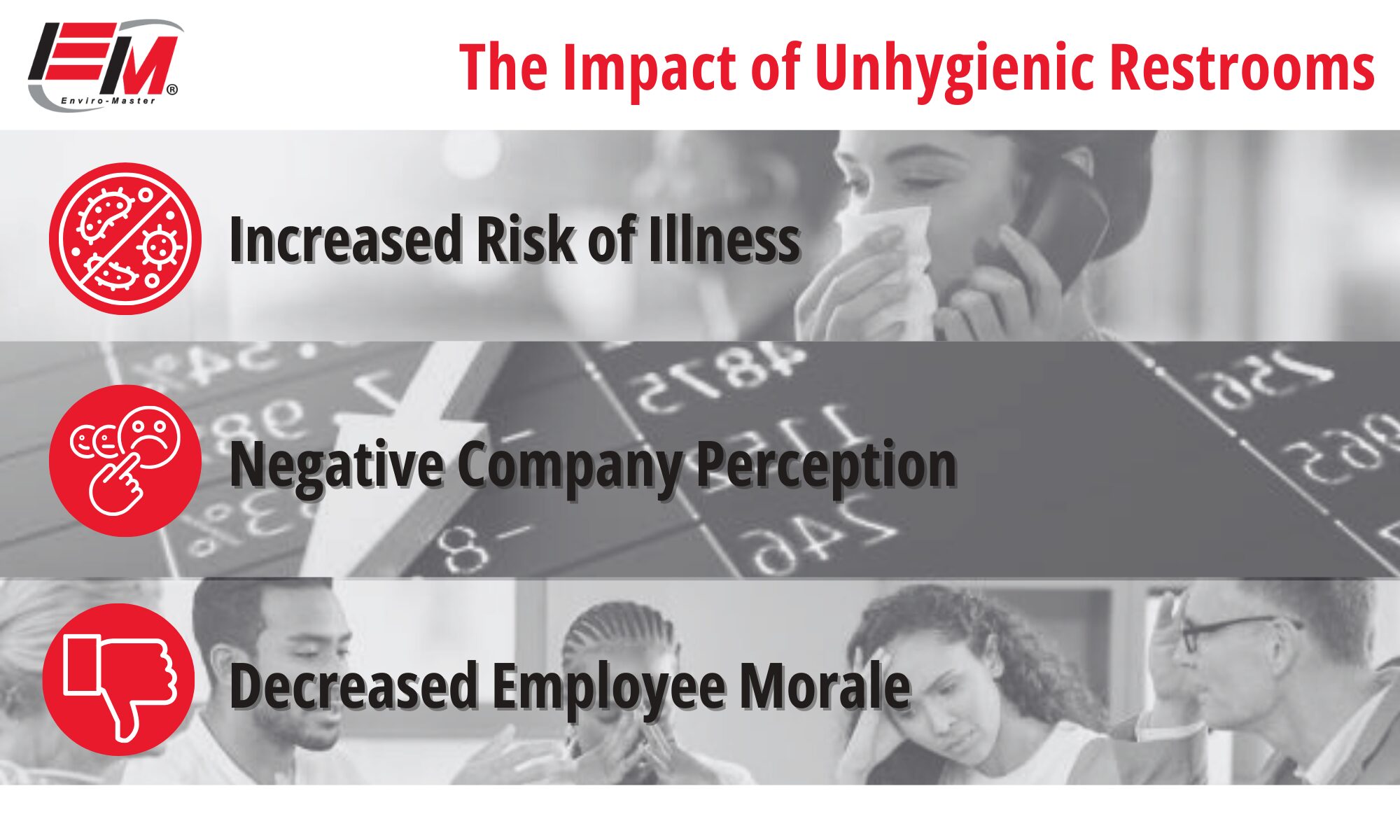When asked what contributes to employee satisfaction and retention, managers are quick to mention salary, benefits, advancement opportunities, and company culture. But how often do we consider the influence of simple cleanliness, particularly the regular maintenance of a company’s restrooms?
Unpleasant odors, unsanitary conditions, and a lack of basic supplies send a message – and not a good one. Maintaining a clean and healthy restroom environment is much more than a mere task on the janitorial checklist. It directly influences job satisfaction, staff morale, and significantly, the decision of an employee to remain with a company or seek employment elsewhere. Throughout this blog post, we will explore how restroom hygiene plays a crucial role in shaping a company’s turnover rate.
Understanding Employee Turnover and its Connection to Restroom Hygiene
Employee turnover is a prevalent issue faced by organizations worldwide. Employee turnover refers to the rate at which employees leave a company and are replaced by new hires over a specific period. While some amount of turnover is inevitable, and can even be beneficial, a high turnover rate raises concerns.
Now, you may wonder, how does restroom hygiene relate to this concept of employee turnover? Often overlooked or considered insignificant, the cleanliness and maintenance of office restrooms can heavily impact the turnover rate. Employees spend a considerable part of their day at the workplace and hence a clean, well-maintained restroom significantly contributes to their sense of comfort and job satisfaction. However, when neglected, it can breed dissatisfaction, adversely affecting employee engagement and morale.
There are two main types of turnover – voluntary and involuntary:
Voluntary Turnover
Voluntary turnover occurs when an employee leaves willingly, often driven by factors such as lack of career growth, better job opportunities, or dissatisfaction with the workplace environment, of which restroom hygiene can be an influential element. A high voluntary turnover rate might signal larger issues within the company’s culture or environment, including overlooked aspects like restroom cleanliness.
Involuntary Turnover
Meanwhile, involuntary turnover happens when the decision to exit comes from the company, often linked to poor performance or downsizing. High involuntary turnover mostly suggests concerns with recruitment and management processes.
Impact of High Turnover
High turnover of any kind presents various challenges such as:
- Reduced productivity
- Increased recruitment
- Training costs
- Disruption to the functioning of the business
- Negative impact on the remaining employees
After learning the concept of employee turnover and its potential link to restroom hygiene, it becomes easier to comprehend why business leaders should not dismiss the seemingly simple matter of a well-maintained restroom facility.
The Hidden Costs of Employee Turnover
To fully appreciate the importance of restroom hygiene in managing employee turnover, it is crucial to understand the costs associated with losing an employee. Turnover is not just about losing a team member; it has significant direct and indirect costs that can impact your company’s bottom line and overall functioning.
Direct Costs
Direct costs are typically expenses straightforward to track. They include the cost of recruitment activities such as advertising open positions, interviewing, and background checks, as well as training and onboarding costs for the new hires. This learning period often leads to reduced productivity and lower work quality.
Indirect Costs
The indirect costs are no less important. They involve impacts on employee morale, productivity, and the maintained reputation of your company. High employee turnover can lead to remaining staff members feeling overworked and stressed due to increased workload, dropping their morale. Further, seeing many colleagues leave can drive a downward spiraling effect; fostering feelings of insecurity regarding their career progression and stability within the company. When employees are unhappy or stressed, their productivity tends to go down, which can cause a ripple effect across the business. High employee churn also risks damaging your company’s reputation, driving away potential top talent.
From an employee’s perspective, the cleanliness of restroom facilities can greatly affect their perception of the organization and its values, influencing their job satisfaction levels. Poor maintenance and ill-kept restrooms not only pose a health risk but also resonate with negligence toward employee welfare–potentially prompting voluntary turnover, further escalating the negative impact. Considering these ramifications, managing the cleanliness of your company’s restroom becomes an imperative yet simple step in controlling these costs and driving down that dreaded turnover.
Impact of Unhygienic Restrooms
Unlocking the mystery behind employee turnover brings us to this pivotal juncture – restroom cleanliness. While it may seem surprising to some, maintaining cleanliness in the restroom can play a significant role in reducing turnover, influencing both job satisfaction and employee retention. You might wonder how something as simple as restroom hygiene can have such power over factors like turnover. The correlation lies in the overall work experience. A clean, well-maintained restroom promotes a positive work environment, signaling a company that values its employees’ comfort and well-being. However, unhygienic restrooms can depict an image of negligence and instigate feelings of discontent, leading to a possible increase in voluntary employee turnover.
Increased Risk of Illness
Poorly maintained restrooms significantly increase the risk of illness, acting as a breeding space for bacteria and viruses. When employees fall sick due to poor cleanliness at work, they miss days, their productivity decreases, and their job satisfaction takes a hit. They may eventually decide to look for jobs elsewhere, where they believe hygiene standards are better maintained.
Negative Perception of the Company
If new hires perceive a lack of cleanliness and sanitization in restrooms, it might foster a negative initial impression, causing them to reconsider their decision to work for your company. Consider that all their positive experiences can be overshadowed by the negatives encountered due to unsanitary restroom conditions.
Decreased Employee Morale
Unhygienic restrooms can lead to a decline in employee morale. When employees feel their workplace lacks basic cleanliness, it can lower their overall motivation and engagement, making them less enthusiastic about their jobs. This drop in morale can contribute to higher turnover, as employees may seek work environments where their well-being is better prioritized.
So, how can we tackle this issue? By utilizing specialized restroom hygiene services, such as comprehensive restroom and hygiene management, drain treatment, and hand hygiene programs, companies can ensure an immaculate, bacteria-free environment. Services like toilet cleaning help maintain high standards of cleanliness and sanitization. This attention to detail can enhance employee satisfaction and reduce discomfort related to restroom hygiene, thereby acting as a strategic approach to managing turnover.
Enhancing Employee Retention with Enviro-Master
Restroom hygiene has an unexpectedly significant impact on both employee turnover and overall job satisfaction. Taking proactive steps to ensure a clean, comfortable restroom environment isn’t just good office etiquette—it’s a direct investment in your company’s health and future. Enviro-Master guarantees an unparalleled level of restroom hygiene. Our proven methods effectively combat restroom bacteria and other disease-causing pathogens, promoting a safer, healthier environment for your employees. Invest in your restrooms, and watch the transformation in your employee retention—a clean win for everyone involved. Contact Enviro-Master today for more information.





